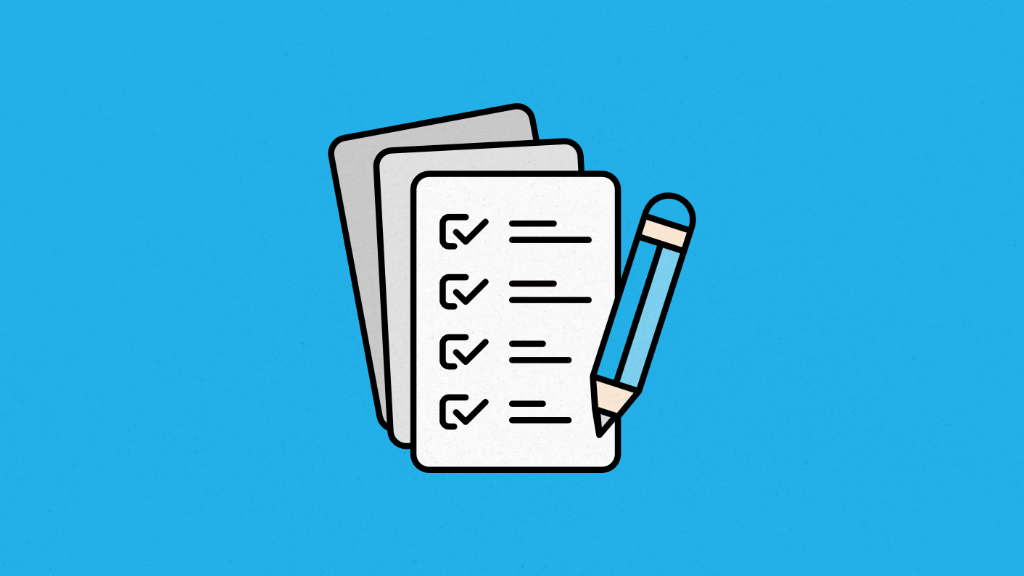Picture a typical workday for a project manager who wakes up with a mental to-do list. He needs to finalize a client proposal, check multiple mails, come up with campaign ideas, review creative drafts, follow up on vendor quotes, and prepare for an afternoon team meeting.
Getting things done is not easy for you when so many tasks swirl in your mind. All these things compete for attention, yet just a few of them get done. This mental juggling causes stress, missed deadlines, and constant overwhelm.
In fact, over 50% of workers report feeling overwhelmed by their workload, and multitasking can reduce productivity by up to 40%. Keeping too many tasks in your head makes you miss details and miss your deadlines.
The solution to this? The Getting Things Done (GTD) method. A simple, structured approach that helps you clear your mind, track tasks reliably, and focus on what matters.
In this article, I’ll discuss everything related to the GTD method, its steps, benefits, and the best GTD tools that you can use right now.
What is the GTD method?
The Getting Things Done (GTD) method, developed by productivity consultant David Allen and introduced in his 2001 book Getting Things Done: The Art of Stress-Free Productivity, is a structured approach to task management aimed at enhancing productivity and reducing stress.
The core principle of the GTD process is to transfer tasks and ideas from one’s mind into an external system, thereby freeing mental space for focused execution.
GTD’s five-step process, Capture, Clarify, Organize, Reflect, and Engage, provides a clear workflow for managing tasks. Implementing GTD can lead to significant benefits.
For instance, a study highlighted that 95% of individuals feel that maintaining a daily task list positively impacts their mental health.
The five key steps of GTD
To truly master Getting Things Done, you need to have a total understanding of the steps included in the process.
In this section, we’ll explore each phase, Capture, Clarify, Organize, Reflect, Engage, and show how following these steps empowers managers to gain control, improve time management, and maximize productivity.
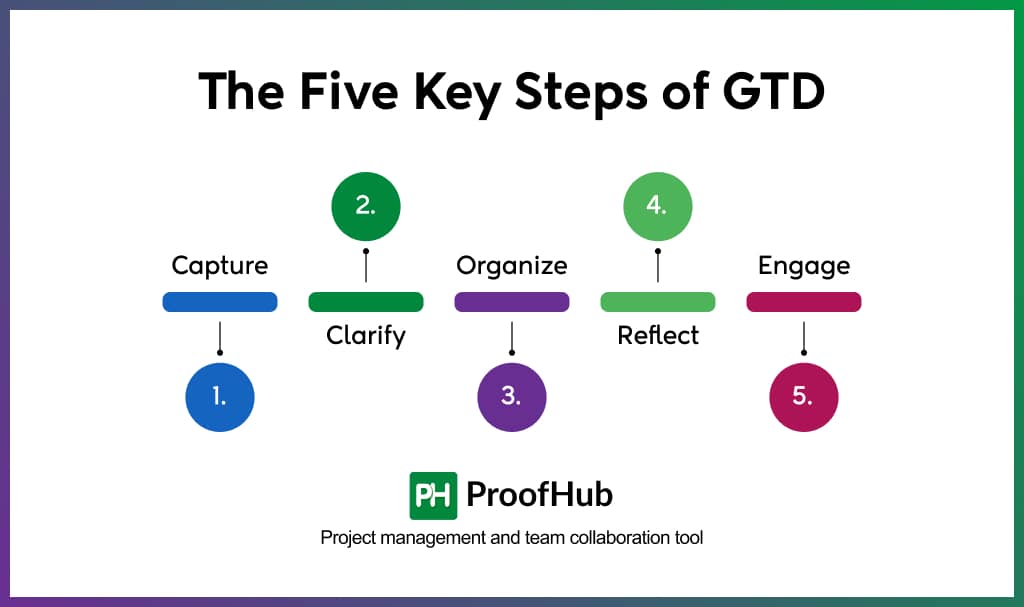
1. Capture
In GTD, ‘Capture’ is the foundational step: gather every idea, task, stakeholder request, project risk, meeting insight, vendor detail, or campaign requirement into a trusted inbox, pen-and-paper, an app, voice memo, etc.
For a project manager, your mental inbox is constantly bombarded with emails, ideas in meetings, performance data, and client requests. Capturing them immediately ensures they don’t slip into mental limbo or get forgotten.
Implementation tips
- Start your day with a 5‑minute brain dump, capturing all pending thoughts before tackling work.
- Choose 1–3 capture mediums, such as an app for tasks, email for communication, and a notebook for creative ideas.
- Use trigger lists during your work to ensure you don’t overlook responsibilities like approvals or deliverables.
Importance
This step alleviates stress and frees up mental bandwidth. Research shows that externalizing commitments clears mental overload. For managers, capturing everything—no matter how small—means nothing falls through the cracks, allowing you to maintain strategic clarity and drive complex initiatives confidently.
2. Clarify
The Clarify step is where you convert captured items into concrete next actions. Ask: “What is this?” and “Is it actionable?” If yes, define the next physical action. If it takes fewer than two minutes, do it immediately. Otherwise, either delegate, defer, or discard.
Implementation tips
- Process each inbox item individually for focused decision-making; don’t multitask.
- Apply the Two-Minute Rule: anything quick, like scheduling a meeting, replying to a client, just do it.
- If it’s a longer task, define the next step clearly (e.g., “draft Instagram ad copy” instead of just “social media”).
- Convert multi-step items into projects by defining outcomes (e.g., “Launch Email Campaign”) and listing the first action.
Importance
Clarifying transforms ambiguity into structure, preventing mental fog. Project managers benefit by separating actions from strategy and ensuring every item is actionable. This reduces decision paralysis and keeps project momentum no more “I’ll get to it later” voodoo.
3. Organize
Organize is about moving clarified items into defined lists: Projects, Next Actions, Calendar, Waiting For, Someday/Maybe. As a project manager, organizing means assigning responsibility, setting deadlines, and structuring your workflow around deliverables.
Implementation tips
- You can use a project management and collaboration tool like ProofHub to create boards and lists aligned with project phases.
- Tag tasks by workflow context (e.g., “@Email”, “@DesignReview”, “@ClientCall”) to trigger actions efficiently.
- For projects, create cards with due dates, milestones, assigned team members, and documented subtasks.
- Use a waiting‑for list to track delegated tasks; follow up proactively without losing oversight. Also, practice time blocking to make time for tasks.
Importance
Organizing ensures full visibility over workflows and responsibilities. It facilitates delegation tracking, prevents tasks from falling through cracks, and aligns team efforts. In a project management platform, where multiple streams run simultaneously, a robust organization layer keeps your system and your team accountable and efficient.
4. Reflect
Reflect, especially during the weekly review, is critical to maintain the integrity and trustworthiness of your GTD system. This dedicated time is used to process new captures, update task lists, clear completed items, and reprioritize.
Implementation tips
- Schedule 1–2 hours weekly (e.g., Friday afternoon) in a distraction-free environment with all resources—calendar, notebook, task system, on hand.
- Use a checklist: empty inboxes, review calendar, process Waiting‑For, update projects, revisit Someday/Maybe.
- Do a daily micro-reflection by glancing at your calendar/tasks in the morning to anticipate needs or adjust priorities.
Importance
Reflecting converts a static setup into a dynamic decision-making hub. It verifies your GTD system is current, aligns actions with goals, and surfaces bottlenecks early. For managers, this fosters predictability in project pipelines, boosts confidence in your planning, and equips you to proactively lead teams toward outcomes.
5. Engage
Engage is execution: selecting tasks from next actions based on context, time available, energy levels, and priority. Productivity techniques are of no use until you put them into action. At this point, the strategy needs to turn into tangible actions.
Implementation tips
- Use Allen’s four‑criteria model: Match tasks to your current context (e.g., “@ClientCall”), remaining time, energy, and strategic priority.
- Optimize downtime: Keep your task list accessible for quick wins during short breaks or pre-meeting intervals.
- Employ timeblocking to structure deep work, schedule chunks dedicated to major deliverables like campaign drafts or analysis.
- Trust the system: When new tasks emerge, capture them instead of interrupting ongoing work. Let your GTD setup guide task selection.
Importance
Engaging effectively transforms prioritized planning into results. For project managers, this means clear, intentional progress, ensuring time is invested in high-impact work aligned with project goals. GTD’s disciplined engagement prevents reactive firefighting and empowers you to deliver on strategy with consistency and control.
Now that we are clear about the Getting Things Done method and the main steps involved in it. Next, I’ll talk about the benefits of using this method.
Benefits of the GTD Method
The Getting Things Done (GTD) method isn’t just about checking off tasks; it’s a powerful system designed to free your mind from clutter and sharpen your focus. Let’s explore the key benefits this method offers:
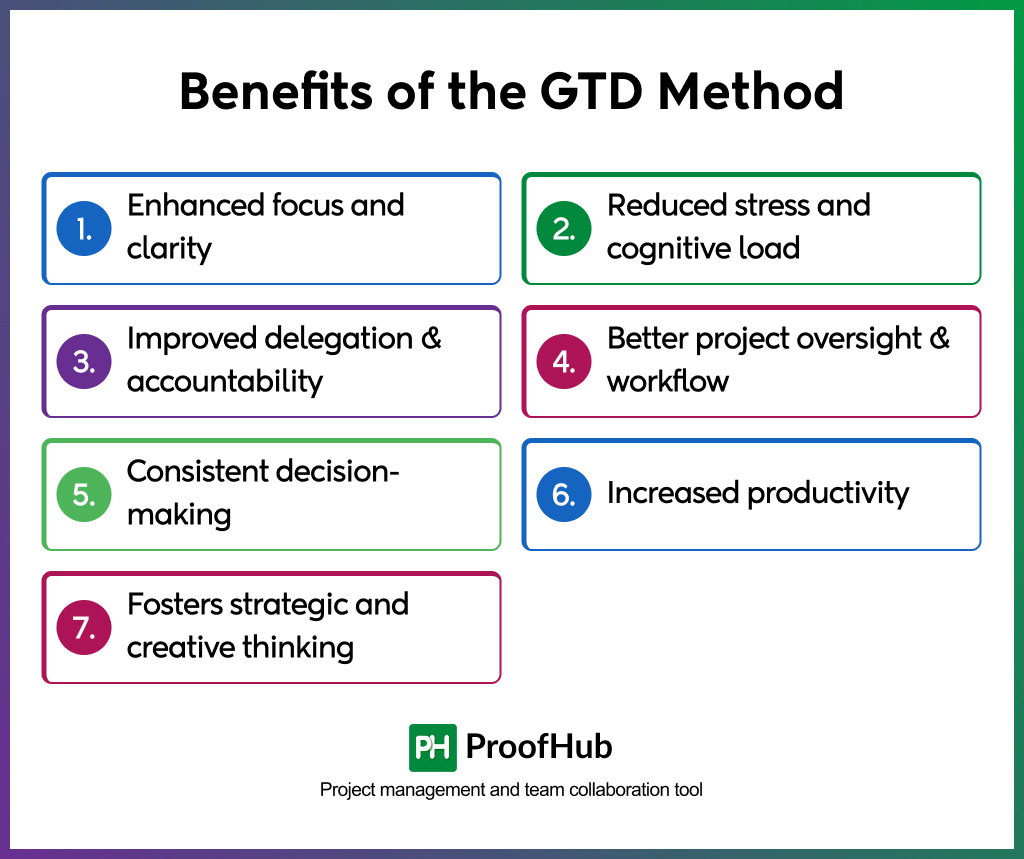
1. Enhanced focus and clarity
By using GTD, you move every task, idea, and responsibility out of your head and into a central system. Whether you use a notebook, an app, or a project tool, everything is documented. This way, you’re not constantly distracted by half‑remembered commitments. Instead, you can dedicate full attention to one task at a time.
Clear next steps and a simplified task-view mean you always know what to do next. For project managers, this makes decision‑making smoother, project meetings productive, and helps the entire team stay focused on key goals, without losing control over details.
2. Reduced stress and cognitive load
The Getting Things Done method dramatically reduces cognitive load by shifting all tasks and commitments out of your head. You don’t have to remember everything constantly.
A calm, clear mind improves decision-making and increases confidence. This productivity method reduces stress and helps teams maintain a healthier work-life balance.
3. Improved delegation & accountability
This method allows you to clearly define the next action, who will do it, and when it’s due. This lets you delegate tasks with confidence and track them properly. Your team understands exactly what “done” looks like, and you keep the task in your “Waiting For” list to follow up without forgetting.
This structure builds trust as team members know their goal and timeline. Also, as you’re monitoring progress, everyone stays accountable. For busy project managers, GTD tasks ensure nothing slips through, responsibilities stay clear, and your team delivers reliably, supporting smooth project flow and stronger performance.
4. Better project oversight & workflow
GTD boosts your ability to see and manage all project plans clearly. By breaking projects into smaller, well-defined tasks, assigning owners, and setting deadlines, nothing gets lost.
This clear structure avoids bottlenecks and confusion. As a manager, you can easily monitor progress, improve resource allocation, reassign work quickly, and keep projects flowing smoothly. GTD ensures full visibility of task status and supports steady, reliable project outcomes.
5. Consistent decision-making
Using the GTD method, all tasks and projects are broken into clearly defined next steps, organized into context‑based lists, and reviewed regularly. This structure helps you avoid guessing what to do next every morning or in meetings; you simply pick the most relevant action.
For project managers managing teams and deadlines, this brings consistency: no more scrambling or indecision. You make informed choices, say “yes” to the right tasks and “no” to distractions. Ultimately, GTD improves your task management abilities, allowing steady, confident decisions that keep projects and teams on track.
6. Increased productivity
Using this method helps you get more done in less time by turning big goals into clear, manageable steps and focusing on one task at a time. Managers who apply it often see at least a 20% boost in personal productivity, according to a Life Architect study with GTD implementers.
By regularly capturing, organizing, and reviewing tasks, GTD prevents wasted time on guesswork or distractions. This structured approach not only speeds up completion but also improves overall workload management.
7. Fosters strategic and creative thinking
By taking everyday tasks off your mind and into a trusted task management app, GTD frees up mental space for big-picture thinking and new ideas. With fewer small tasks nagging at you, you can focus on strategy, like planning a campaign, or exploring creative ideas, such as new marketing angles.
During weekly reviews, this space helps spark fresh insights and innovative approaches. For project managers, GTD supports both execution and invention: while your system handles the routine steps, your brain is free to explore and strategize. This balance boosts innovation and improves team collaboration at your organization.
Common challenges in implementing GTD
While the Getting Things Done (GTD) method offers powerful benefits, putting it into practice isn’t always easy.
Many people face hurdles from overwhelming setups to maintaining consistency. Let’s explore some common challenges you might encounter when adopting the GTD method.
- System overwhelm and complexity – GTD’s five-step framework, Capture, Clarify, Organize, Reflect, Engage, is powerful, but setting up and consistently maintaining it can feel overwhelming, especially for busy managers. The initial effort of building inboxes, task lists, and review routines may seem daunting. Without a simplified “mini-GTD” approach or small, staged implementation, many give up early and never experience the benefits.
Solution – Start tiny: pick one inbox (notebooks or email), dump everything in there once a day, then sort items into just three categories: Do now (<=2 min), Do later, or Toss. Focus on one ‘next thing’ daily to keep things actionable and simple.
- Fragmentation of tools – Using multiple apps, notebooks, GTD software, and email inboxes for different types of tasks breaks the system’s continuity. This tech scatter reduces trust in your system.
Solution – Sticking to a few well-chosen tools, or even paper notes, helps maintain reliability and ensures everything stays captured and visible. Consolidate into one unified tool, automate syncing from others, and conduct a daily ‘multi-inbox sweep’ to merge all tasks.
- Information overload – GTD encourages capturing every idea and request, but this can lead to long, crowded lists full of small, trivial items. With so many entries, it’s harder to see real priorities. Important next actions become hidden, which increases stress and slows decision-making.
Solution – Managers may need to prune regularly to spotlight key tasks, group similar tasks together, and trash outdated notes to keep clarity intact. Also, you can prioritize tasks with Eisenhower matrix or the ABC method - Lapses in review – Skipping the daily or weekly reviews breaks GTD’s rhythm. Without regular review, inboxes fill, next-action lists go stale, and projects stall. The system stops reflecting reality and loses credibility. For managers, this means missed deadlines and a messed-up time management system.
Solution – Setting firm reminders helps keep the review system alive and accurate. Schedule a consistent 30-minute weekly review. Block it in your calendar, prepare a short checklist, and treat it like a recurring meeting you can’t miss. - Procrastination and over-organization – Some users fall into “productivity paralysis” as they spend more time organizing and tagging tasks in their work management system than actually doing them. They tweak boards, create additional tags, and chase perfect workflows instead of executing.
Solution – Aim for good-enough setups and use time-blocking to ensure actual work gets done before further optimization. Set a 10‑minute planning timer, and then immediately tackle your top task.
Top 5 GTD apps and software that you can use
Managing tasks and projects with GTD becomes far easier when you use the right tools. Whether you’re capturing ideas on the go, reviewing weekly goals, or tracking team assignments, the right app or software can streamline each step of the process.
In this section, I’ve curated a list of the top 5 GTD tools, highlighting their strengths, ideal use cases, and what makes them stand out for project managers. Let’s go through each one individually.
1. ProofHub
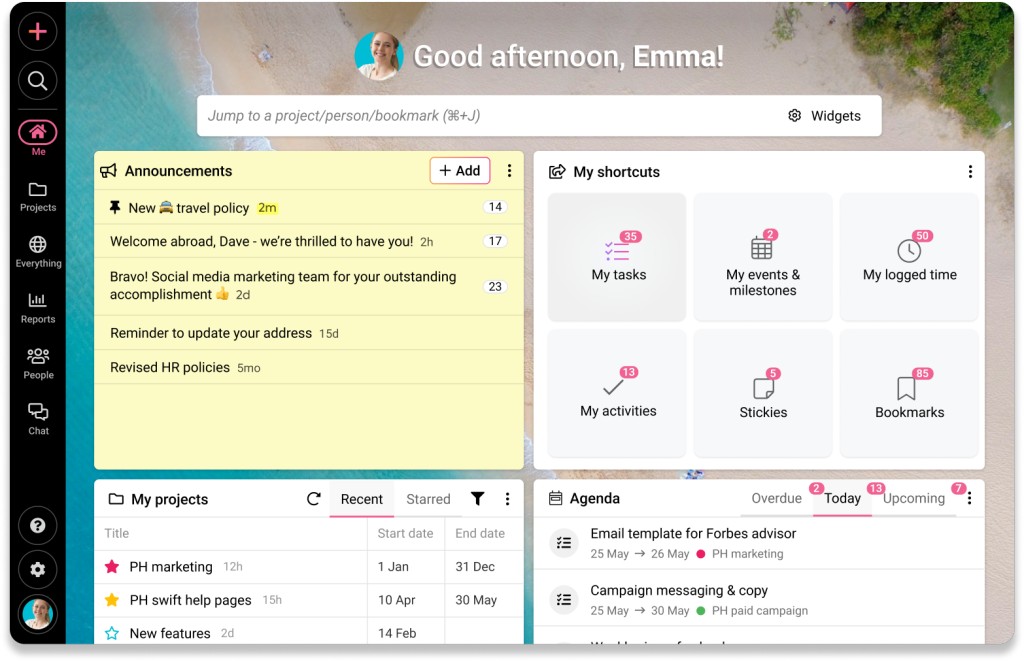
ProofHub is a robust, all-in-one project management tool and collaboration platform that aligns perfectly with GTD principles: capture, clarify, organize, reflect, and engage. It centralizes tasks, discussions, files, and time tracking, making it easy to capture ideas and action items from meetings or emails in one place.
Clear task creation with due dates and assignees aligns with GTD’s “Clarify” and “Organize” steps. Visual Kanban boards support GTD’s “Organize” and “Reflect” steps by showing task status. Built-in timers and reminders enforce GTD’s “Engage” and “Reflect” steps by prompting timely action. Centralized comments and proofing tools streamline GTD’s “Capture” and “Clarify” steps by keeping feedback linked to relevant tasks. Personal “Me View” dashboard helps GTD’s “Engage” step by highlighting each user’s next actions and deadlines.
2. Nirvana
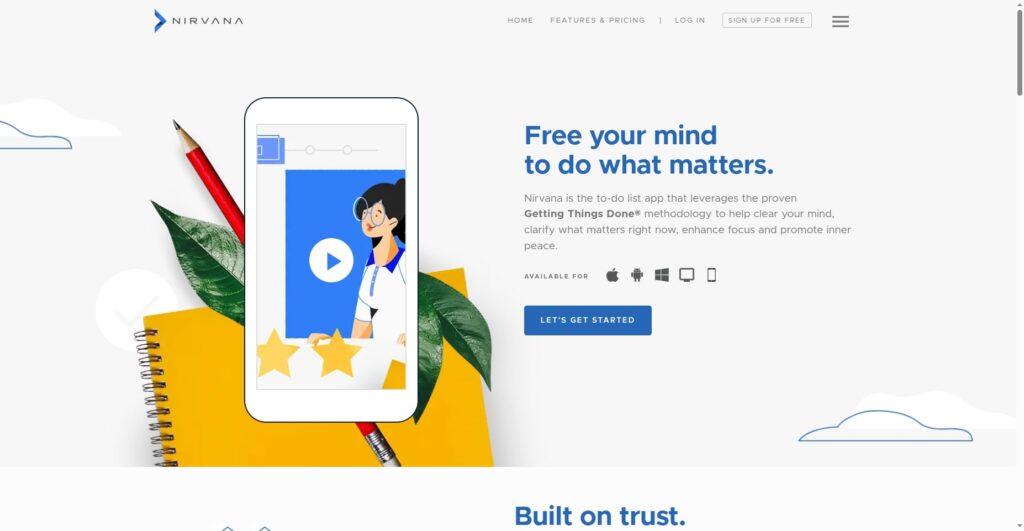
Nirvana is a purpose-built GTD task manager that simplifies capturing, organizing, and completing work. With pre-defined sections like Inbox, Next, Projects, Waiting, Scheduled, and Someday, users get a structured workflow that mirrors GTD’s five steps. This helps a lot in putting your time management techniques into practice.
The tool excels at handling recurring tasks intelligently and keeping scheduled items hidden until they become relevant. One Reddit user noted it’s “amazing! Best solution I have found by a long shot” for true GTD methodology implementation. For non‑tech managers, the Nirvana Get Things Done software offers a clean, focused interface that keeps your mind clear and your next actions obvious.
3. Todoist
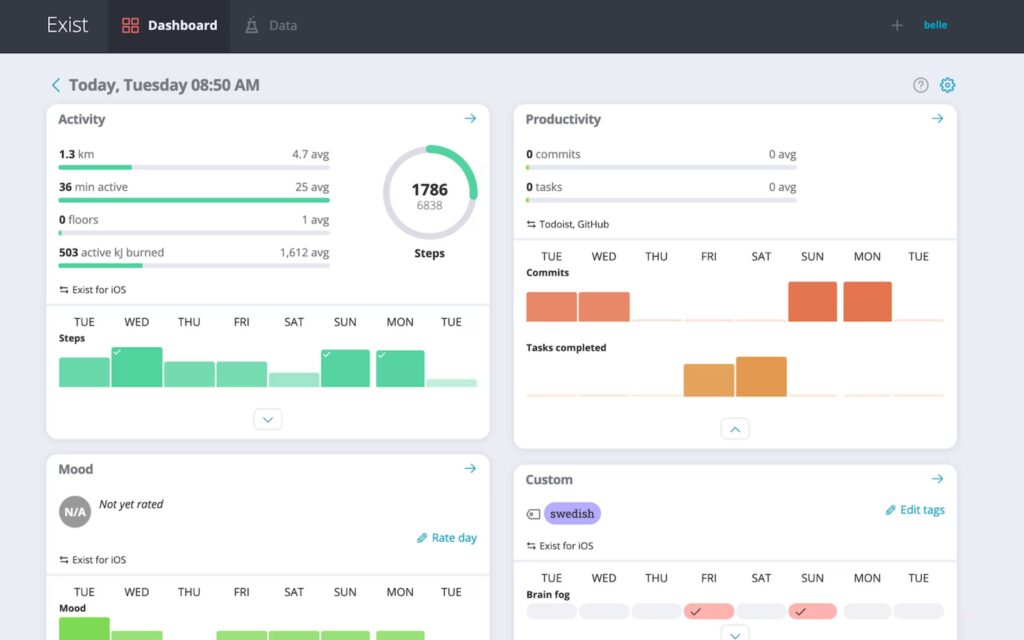
One of the best apps for the GTD method, Todoist offers quick capturing via natural language and global shortcuts, ensuring no task slips through. Tasks can be clarified into clear next actions and organized into projects, labels, and priority levels, then reviewed and reprioritized during weekly check-ins.
With reminders, recurring tasks, and a clean interface synced across devices, Todoist helps you with your GTD project planning. This structure boosts productivity, reduces mental clutter, and supports reliable execution for both personal and team-focused project work. With some of the best task management features, Todoist is a must-use option for everyone.
4. Evernote
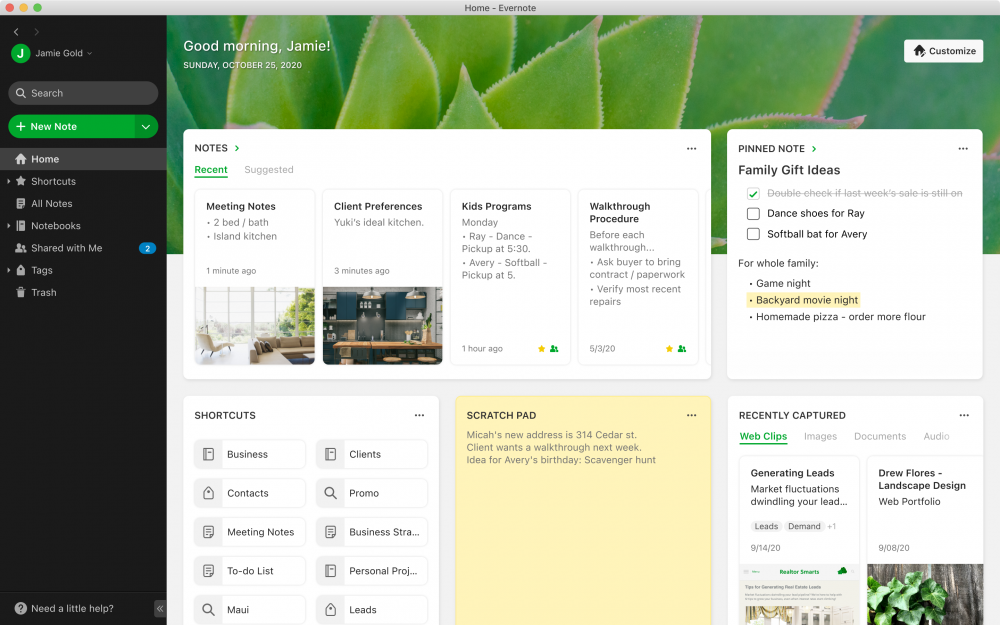
Evernote is one of the best apps for Getting Things Done and a versatile tool that supports all five GTD steps within a single platform. It excels as a centralized inbox for notes, emails, web clips, and PDFs, ensuring nothing slips through the cracks. Users create notebooks for projects, tag items by status, and use advanced search to quickly find relevant information.
Its cross-platform access, including offline modes, means you can review and act on tasks anytime. For project managers, Evernote keeps ideas, materials, and actions together in one clean, reliable workspace. This reduces clutter and makes productivity simple and effective.
5. Remember the Milk

Remember The Milk is a user-friendly task manager that supports GTD well, ideal for both personal and work contexts. It lets you capture tasks quickly through web, mobile, email, or voice input and organize them into lists, tags, start dates, and priorities.
Smart Lists help you view “Next Actions,” “Waiting For,” or “Soon” at a glance, aligning with GTD’s clarity and organization needs. With reminders, recurring tasks, offline access, and cross-device sync, it ensures no task slips through and makes managing projects simple.
Conclusion
The Getting Things Done (GTD) method offers a proven framework for boosting productivity, reducing stress, and staying on top of complex responsibilities, especially for project managers. By following its five core steps: Capture, Clarify, Organize, Reflect, and Engage, you can create a trusted system.
This frees your mind from clutter and improves focus, decision-making, and execution. While challenges exist in implementation, the right tools make it far easier to adopt GTD effectively. ProofHub stands out as an ideal GTD tool that combines clarity, control, and collaboration in one powerful, easy-to-use platform. It makes sure that you do not forget any of your tasks and complete all your projects within their deadlines.
Frequently asked questions
How does GTD improve productivity?
GTD boosts productivity by clearing your mind of “open loops” and capturing every task into a trusted external system, so you can fully focus on real work. Breaking tasks into concrete next actions removes indecision, while regular reviews ensure alignment with priorities. Studies show GTD users often see at least a 20 % gain in personal effectiveness
How does GTD handle recurring tasks or long-term goals?
GTD handles recurring tasks and long-term goals by treating them as projects with clear next actions or scheduled reminders. Recurring items can be managed via calendar entries, tickler files, or checklists reviewed weekly. Long-term goals follow the same logic: break them into chunked, dated next actions and capture them during weekly reviews
Can GTD be combined with other productivity methodologies like Agile or Pomodoro?
GTD easily integrates with other productivity methods like Pomodoro and Agile by adding structure and focus. Use GTD to identify and prioritize tasks, then apply Pomodoro’s 25‑minute sprints for execution and breaks in between. Agile principles like sprint planning and iterative reviews work well with GTD’s Reflect step, ensuring flexibility and continuous refinement. Many users report that this hybrid enhances motivation and efficiency.
